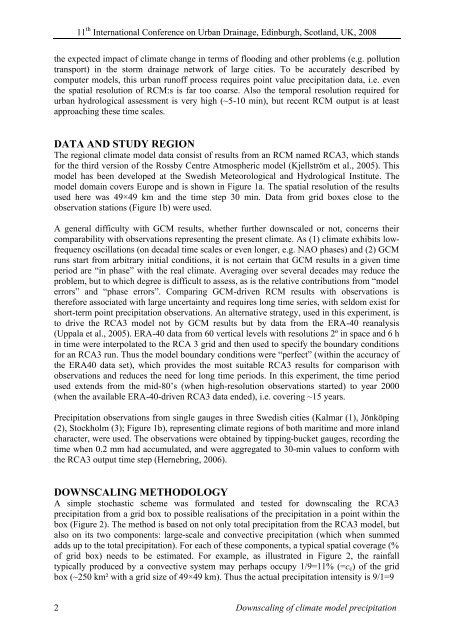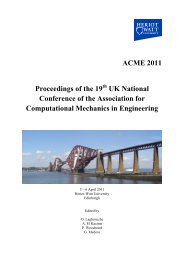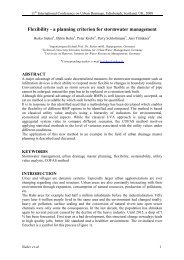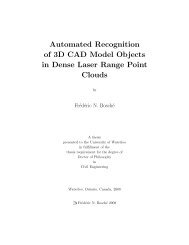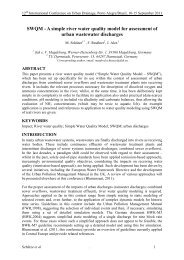Downscaling of Regional Climate Model Precipitation for Urban ...
Downscaling of Regional Climate Model Precipitation for Urban ...
Downscaling of Regional Climate Model Precipitation for Urban ...
Create successful ePaper yourself
Turn your PDF publications into a flip-book with our unique Google optimized e-Paper software.
11 th International Conference on <strong>Urban</strong> Drainage, Edinburgh, Scotland, UK, 2008<br />
the expected impact <strong>of</strong> climate change in terms <strong>of</strong> flooding and other problems (e.g. pollution<br />
transport) in the storm drainage network <strong>of</strong> large cities. To be accurately described by<br />
computer models, this urban run<strong>of</strong>f process requires point value precipitation data, i.e. even<br />
the spatial resolution <strong>of</strong> RCM:s is far too coarse. Also the temporal resolution required <strong>for</strong><br />
urban hydrological assessment is very high (~5-10 min), but recent RCM output is at least<br />
approaching these time scales.<br />
DATA AND STUDY REGION<br />
The regional climate model data consist <strong>of</strong> results from an RCM named RCA3, which stands<br />
<strong>for</strong> the third version <strong>of</strong> the Rossby Centre Atmospheric model (Kjellström et al., 2005). This<br />
model has been developed at the Swedish Meteorological and Hydrological Institute. The<br />
model domain covers Europe and is shown in Figure 1a. The spatial resolution <strong>of</strong> the results<br />
used here was 49×49 km and the time step 30 min. Data from grid boxes close to the<br />
observation stations (Figure 1b) were used.<br />
A general difficulty with GCM results, whether further downscaled or not, concerns their<br />
comparability with observations representing the present climate. As (1) climate exhibits lowfrequency<br />
oscillations (on decadal time scales or even longer, e.g. NAO phases) and (2) GCM<br />
runs start from arbitrary initial conditions, it is not certain that GCM results in a given time<br />
period are “in phase” with the real climate. Averaging over several decades may reduce the<br />
problem, but to which degree is difficult to assess, as is the relative contributions from “model<br />
errors” and “phase errors”. Comparing GCM-driven RCM results with observations is<br />
there<strong>for</strong>e associated with large uncertainty and requires long time series, with seldom exist <strong>for</strong><br />
short-term point precipitation observations. An alternative strategy, used in this experiment, is<br />
to drive the RCA3 model not by GCM results but by data from the ERA-40 reanalysis<br />
(Uppala et al., 2005). ERA-40 data from 60 vertical levels with resolutions 2º in space and 6 h<br />
in time were interpolated to the RCA 3 grid and then used to specify the boundary conditions<br />
<strong>for</strong> an RCA3 run. Thus the model boundary conditions were “perfect” (within the accuracy <strong>of</strong><br />
the ERA40 data set), which provides the most suitable RCA3 results <strong>for</strong> comparison with<br />
observations and reduces the need <strong>for</strong> long time periods. In this experiment, the time period<br />
used extends from the mid-80’s (when high-resolution observations started) to year 2000<br />
(when the available ERA-40-driven RCA3 data ended), i.e. covering ~15 years.<br />
<strong>Precipitation</strong> observations from single gauges in three Swedish cities (Kalmar (1), Jönköping<br />
(2), Stockholm (3); Figure 1b), representing climate regions <strong>of</strong> both maritime and more inland<br />
character, were used. The observations were obtained by tipping-bucket gauges, recording the<br />
time when 0.2 mm had accumulated, and were aggregated to 30-min values to con<strong>for</strong>m with<br />
the RCA3 output time step (Hernebring, 2006).<br />
DOWNSCALING METHODOLOGY<br />
A simple stochastic scheme was <strong>for</strong>mulated and tested <strong>for</strong> downscaling the RCA3<br />
precipitation from a grid box to possible realisations <strong>of</strong> the precipitation in a point within the<br />
box (Figure 2). The method is based on not only total precipitation from the RCA3 model, but<br />
also on its two components: large-scale and convective precipitation (which when summed<br />
adds up to the total precipitation). For each <strong>of</strong> these components, a typical spatial coverage (%<br />
<strong>of</strong> grid box) needs to be estimated. For example, as illustrated in Figure 2, the rainfall<br />
typically produced by a convective system may perhaps occupy 1/9=11% (=cc) <strong>of</strong> the grid<br />
box (~250 km² with a grid size <strong>of</strong> 49×49 km). Thus the actual precipitation intensity is 9/1=9<br />
2 <strong>Downscaling</strong> <strong>of</strong> climate model precipitation


